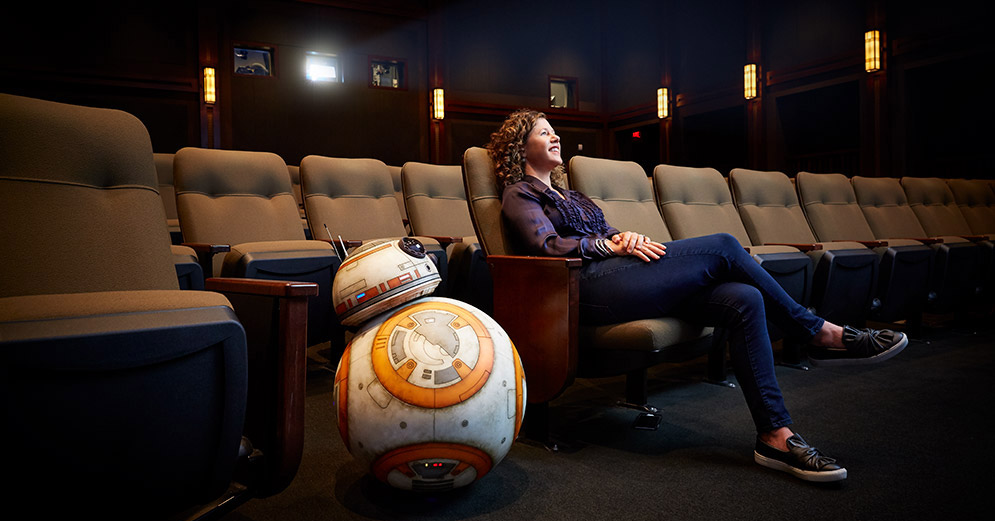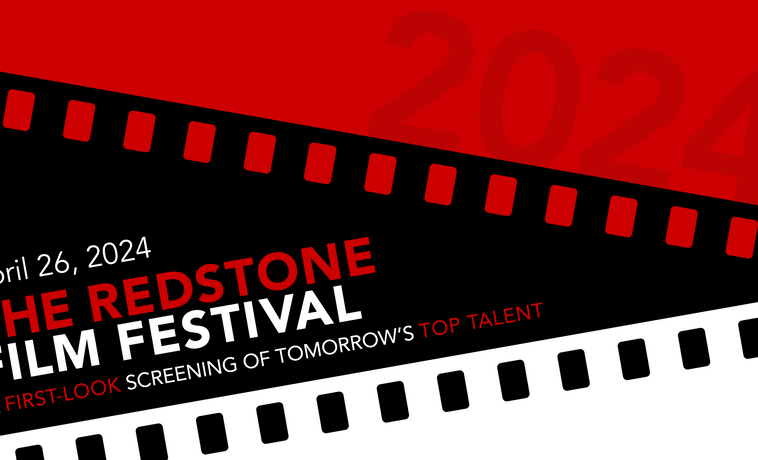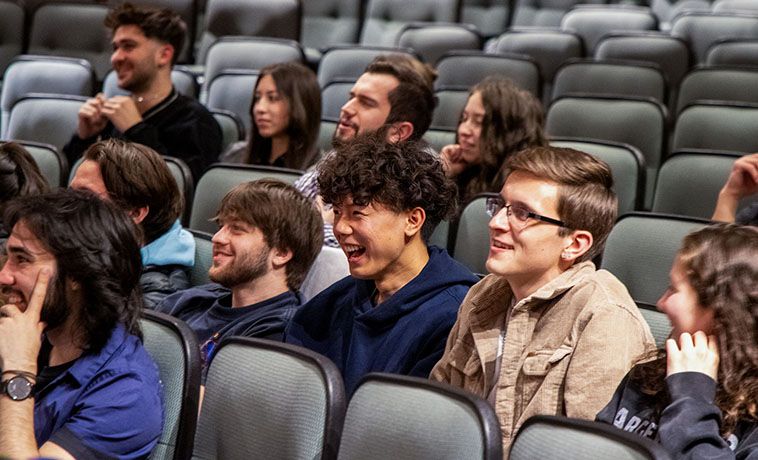Undergrad convocation speaker talks curiosity, hard work—and Star Wars
Lucasfilm Exec and COM Alum Janet Lewin to Address the Class of 2022

Janet Lewin (CGS’90, COM’92), with droid BB-8 in a screening theater at Lucasfilm in San Francisco, takes the Star Wars groundbreaking visual effects from ambitious ideas to fully executed realities. Photo by Mitch Tobias
Janet Lewin remembers sitting at her own BU Commencement ceremony in 1992 and wondering what she would do with her career. Thirty years later she’s returning to tell COM’s undergraduate Class of 2022: The journey ahead may surprise you.
Soon after graduating, Lewin (CGS’90, COM’92) landed a temp job in the purchasing department at Industrial Light and Magic (ILM), the special effects division at Lucasfilm. She learned the business, grew with the company and, today, well, she runs the place. As general manager of ILM, she’s in charge of five studios, along with production, operations, talent management, strategic planning and all of the company’s client management. On top of that, she’s a senior vice president of visual effects for Lucasfilm, the studio behind the Star Wars franchise, overseeing budgets, scheduling, staffing and other planning for the company’s movies, shows and theme parks.
Lewin has helped to produce visual effects for six Star Wars films and a long list of effects-packed franchises, including Indiana Jones, Marvel, Mission Impossible, Star Trek and Terminator. Most recently, she’s helped ILM implement its revolutionary StageCraft LED volume technology. These virtual sets allow actors to perform in front of scenes projected on massive LED screens, creating the illusion of real settings but in the controlled environment of a studio.
Lewin, who will address COM’s undergraduate convocation on Friday, May 20, spoke with COMtalk about Star Wars, pioneering film technologies and her message to today’s college graduates.
Q&A
With Janet Lewin
COMtalk: What do you plan to say to the Class of 2022?
Janet Lewin: The theme is that you don’t know what the future holds, you don’t know where your career will take you. You’re about to start this exciting journey, but know that the world is going to change dramatically, as it did for me. And you will change along with it. Thirty years ago, when I was sitting where they are today, there was no such thing as Amazon and the internet, cell phones, distributed media—and this explosion of innovations have evolved since then. When I graduated, I didn’t really know what I wanted to do with my life, and that’s OK. I found my path through curiosity and hard work and getting out of my comfort zone.
COMtalk: Despite your uncertainty, you landed at a company where you’ve spent almost your entire career. To what do you attribute that?
Janet Lewin: Mostly, it’s the brilliant people I get to work with. But, I think it’s also because the industry is constantly evolving. It’s innovative, it’s challenging, it’s global, and so I’ve never felt like there was a ceiling for my growth or my learning.
COMtalk: How much does today’s film industry resemble the one you started working in back in the 1990s?
Janet Lewin: The big change is scale. When I started, visual effects was sort of a nascent art form. The digital revolution in filmmaking had just started and computer graphics were used very sparingly. Modern filmmaking now relies on visual effects in every medium and sometimes in every shot. Whether it’s commercials or music videos or theme park rides or feature animation, we’re involved in all of it. ILM is a reflection of that: when I started, ILM employed fewer than 200 people in Marin County, California—now there are 3,000 around the globe.
COMtalk: What’s the biggest technological breakthrough in recent years?
Janet Lewin: Virtual production. That includes the [StageCraft] techniques that really came to fruition on The Mandalorian, but ILM has been at the forefront of developing these techniques for the last 20 years. StageCraft technology enables high-resolution computer graphic 3D imagery, projected in real time on LED screens to allow for in-camera visual effects. It’s now a huge part of our business, in part thanks to the interest generated during the pandemic, since virtual production allows for fewer company moves to location. We’re offering these services to lots of different clients in addition to Lucasfilm, like Marvel, and we recently completed virtual production on The Batman.
COMtalk: What are the creative advantages?
Janet Lewin: The major advantage is that all of your key creatives are there on the day that you’re shooting, so they can make interesting choices about shot design that they might not make if the actors were just being shot against a green screen. LEDs are a lighting instrument, so you’re also getting true interactive light on your characters and sets. That is very difficult to replicate in a composite. And the third advantage is your actors are immersed in their environment. They deliver a different performance based on what they’re seeing and experiencing in real time. On Solo, Alden Ehrenreich, who plays Han Solo, was in a shot in the Millennium Falcon cockpit, going into hyperspace. You could see the reflection of hyperspace in his eyes and he had this awestruck expression, because it was quite thrilling to be in that setting. It wound up being this amazing shot that the filmmakers never would have conceived without this technology.
COMtalk: How has that technology evolved?
Janet Lewin: We did on-set, real-time visualization for AI back in about 2000. That was sort of the beginning of virtual production for us. We started exploring the use of LEDs on Rogue One, but at that time the pixel size of the LEDs was so large that you couldn’t shoot directly into them without seeing the pixelation of the imagery, so they were primarily used for interactive light and actor immersion. In fact, to shoot into them, we had to use shower curtains to diffuse the LEDs. But we started to see the power of this technique, and it was really [creator and executive producer] Jon Favreau and [director of photography] Greig Fraser, on The Mandalorian, who pushed us to get to that holy grail combination of shooting directly into the LEDs with real-time environments for in-camera visual effects shots.
COMtalk: Members of every department at COM consider themselves storytellers, and Star Wars is one of the defining stories of our time. What’s something that they can learn from its success?
Janet Lewin: The heart of Star Wars is about friendship—challenging the Dark Side and banding together with a team of friends to conquer evil. Although it’s a simple story in today’s world, it still resonates and we’re embracing different perspectives, which makes it exciting and relevant. We have a lot more diverse characters in our projects and more diverse storytellers. So, we’re fortunate to have a beloved franchise with vast opportunities to tell new, inclusive stories that still resonate from that original concept.
COMtalk: Obi-Wan Kenobi, the next Star Wars project, premieres on Disney+ on May 27. What’s something you’re excited about with that show?
Janet Lewin: It’s our first episodic project completely directed and showrun by a woman. So that’s pretty cool. Deb Chow is amazing. Just an example of how we are evolving our brand and our storytelling to be more inclusive.
This interview has been edited for clarity and brevity.


